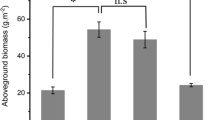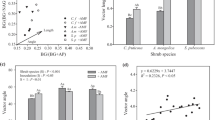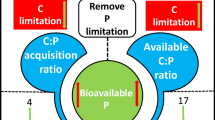Abstract
Shrub encroachment changes the patterns of nutrition allocation in the below- and aboveground soil. However, influence of shrub encroachment on microbial carbon (C) and nitrogen (N) limitations remains unclear. Using the extracellular enzyme stoichiometry model, microbial nutrition limitations in bulk and rhizosphere soils at various soil layers were investigated at non-shrub alpine grasslands (GL) and shrub-encroached alpine grasslands including Spiraea alpina lands (SA), Caragana microphylla lands (CM) and Potentilla fruticosa lands (PF) on the Qinghai-Tibetan Plateau. We determined C-acquisition (β-1,4-glucosidase (BG); β-D-fibrinosidase (CBH)), N-acquisition (β-1,4-N-acetylglucosaminidase (NAG); leucine aminopeptidase (LAP)) and phosphorus (P)-acquisition (acid phosphatase (AP)) enzyme activities. The contents of soil organic carbon (SOC) in top- and subsoils significantly increased following shrub encroachment. Interestingly, (LAP + NAG) activities in subsoil increased following shrub encroachment. EC:N in subsoil decreased following shrub encroachment. Microbial C and N limitations were found in shrub-encroached and non-shrub alpine grasslands. Furthermore, microbial C and N limitations in bulk topsoil layers decreased following shrub encroachment. Microbial N limitations in subsoil decreased following shrub encroachment. This result indicates that shrub encroachment mitigated microbial C and N limitations. The limitations were gradually mitigated following shrub encroachment, which led to the decrease of the decomposition rate of organic carbon by microorganisms, indicating shrub encroachment might potentially contribute to SOC storage. In addition, the structural equation modeling (SEM) showed that increases of SOC and NH4+–N in top- and subsoils under shrub encroachment could mitigate microbial C and N limitations, respectively. This study provides available information on the environmental variables affecting the stoichiometry of extracellular enzymes following shrub encroachment, and the theoretical basis for the study of C and N cycling in alpine grasslands.
Graphical abstract









Similar content being viewed by others
Data availability
Enquiries about data availability should be directed to the authors.
References
Ai C, Liang G, Sun J, Wang X, Zhou W (2012) Responses of extracellular enzyme activities and microbial community in both the rhizosphere and bulk soil to long-term fertilization practices in a fluvo-aquic soil. Geoderma 173:330–338
Akinyemi DS, Zhu Y, Zhao M, Zhang P, Shen H, Fang J (2020) Response of soil extracellular enzyme activity to experimental precipitation in a shrub-encroached grassland in Inner Mongolia. Glob Ecol Conserv 23:e01175
Bardgett RD, Mommer L, De Vries FT (2014) Going underground: root traits as drivers of ecosystem processes. Trends Ecol Evol 29(12):692–699
Bi B, Wang K, Zhang H, Wang Y, Fei H, Pan R, Han F (2021) Plants use rhizosphere metabolites to regulate soil microbial diversity. Land Degrad Dev 32(18):5267–5280
Biederman LA, Boutton TW (2009) Biodiversity and trophic structure of soil nematode communities are altered following woody plant invasion of grassland. Soil Biol Biochem 41(9):1943–1950
Binkley D, Richter D (1987) Nutrient cycles and H+ budgets of forest ecosystems. In: Binkley D, Richter D (eds) Advances in ecological research. Elsevier, pp 1–51
Brandt JS, Haynes MA, Kuemmerle T, Waller DM, Radeloff VC (2013) Regime shift on the roof of the world: alpine meadows converting to shrublands in the southern Himalayas. Biol Cons 158:116–127
Cao C, Jiang S, Ying Z, Zhang F, Han X (2011) Spatial variability of soil nutrients and microbiological properties after the establishment of leguminous shrub Caragana microphylla Lam. plantation on sand dune in the Horqin Sandy Land of Northeast China. Ecol Eng 37(10):1467–1475
Carrasco L, Azcón R, Kohler J, Roldán A, Caravaca F (2011) Comparative effects of native filamentous and arbuscular mycorrhizal fungi in the establishment of an autochthonous, leguminous shrub growing in a metal-contaminated soil. Sci Total Environ 409(6):1205–1209
Chen Y, Feng J, Yuan X, Zhu B (2020) Effects of warming on carbon and nitrogen cycling in alpine grassland ecosystems on the Tibetan Plateau: a meta-analysis. Geoderma 370:114363
Chen H, Ju P, Zhu Q, Xu X, Wu N, Gao Y, Feng X, Tian J, Niu S, Zhang Y (2022) Carbon and nitrogen cycling on the Qinghai-Tibetan Plateau. Nat Rev Earth Environ 3(10):701–716
Cui Y, Fang L, Guo X, Wang X, Zhang Y, Li P, Zhang X (2018) Ecoenzymatic stoichiometry and microbial nutrient limitation in rhizosphere soil in the arid area of the northern Loess Plateau, China. Soil Biol Biochem 116:11–21
Cui Y, Bing H, Fang L, Jiang M, Shen G, Yu J, Wang X, Zhu H, Wu Y, Zhang X (2021) Extracellular enzyme stoichiometry reveals the carbon and phosphorus limitations of microbial metabolisms in the rhizosphere and bulk soils in alpine ecosystems. Plant Soil 458:7–20
Dick RP (1994) Soil enzyme activities as indicators of soil quality. Defin Soil Quality Sustain Environ 35:107–124
Dieleman CM, Lindo Z, McLaughlin JW, Craig AE, Branfireun BA (2016) Climate change effects on peatland decomposition and porewater dissolved organic carbon biogeochemistry. Biogeochemistry 128:385–396
Dijkstra FA, Carrillo Y, Pendall E, Morgan JA (2013) Rhizosphere priming: a nutrient perspective. Front Microbiol 4:216
Ding Y, Huang X, Li Y, Liu H, Zhang Q, Liu X, Xu J, Di H (2021) Nitrate leaching losses mitigated with intercropping of deep-rooted and shallow-rooted plants. J Soils Sediments 21:364–375
Domenach A-M, Moiroud A, Jocteur-Monrozier L (1994) Leaf carbon and nitrogen constituents of some actinorhizal tree species. Soil Biol Biochem 26(5):649–653
Eldridge DJ, Bowker MA, Maestre FT, Roger E, Reynolds JF, Whitford WG (2011) Impacts of shrub encroachment on ecosystem structure and functioning: towards a global synthesis. Ecol Lett 14(7):709–722
Fayiah M, Dong S, Li Y, Xu Y, Gao X, Li S, Shen H, Xiao J, Yang Y, Wessell K (2019) The relationships between plant diversity, plant cover, plant biomass and soil fertility vary with grassland type on Qinghai-Tibetan Plateau. Agr Ecosyst Environ 286:106659
Feng D, Bao W (2018) Shrub encroachment alters topsoil C:N:P stoichiometric ratios in a high-altitude forest cutover. Iforest-Biogeosci For 11(5):594
Fujii Y, Furubayashi A, Hiradate S (2005) Rhizosphere soil method: a new bioassay to evaluate allelopathy in the field. In: Fujii Y, Furubayashi A & Hiradate S (eds) Proceedings of the 4th world congress on allelopathy: establishing the scientific base, pp 21–26
Gao X-l, Li X, Zhao L, Kuzyakov Y (2021) Shrubs magnify soil phosphorus depletion in Tibetan meadows: conclusions from C:N:P stoichiometry and deep soil profiles. Sci Total Environ 785:147320
German DP, Weintraub MN, Grandy AS, Lauber CL, Rinkes ZL, Allison SD (2011) Optimization of hydrolytic and oxidative enzyme methods for ecosystem studies. Soil Biol Biochem 43(7):1387–1397
Gómez-Rey MX, Madeira M, Gonzalez-Prieto SJ, Coutinho J (2013) Soil C and N dynamics in a Mediterranean oak woodland with shrub encroachment. Plant Soil 371:339–354
Grandy AS, Neff JC, Weintraub MN (2007) Carbon structure and enzyme activities in alpine and forest ecosystems. Soil Biol Biochem 39(11):2701–2711
He W, Wu F, Zhang D, Yang W, Tan B, Zhao Y, Wu Q (2015) The effects of forest gaps on cellulose degradation in the foliar litter of two shrub species in an alpine fir forest. Plant Soil 393:109–122
Hewins DB, Sinsabaugh RL, Archer SR, Throop HL (2017) Soil–litter mixing and microbial activity mediate decomposition and soil aggregate formation in a sandy shrub-invaded Chihuahuan Desert grassland. Plant Ecol 218:459–474
Hu Z, Li J, Shi K, Ren G, Dai Z, Sun J, Zheng X, Zhou Y, Zhang J, Li G (2021) Effects of Canada goldenrod invasion on soil extracellular enzyme activities and ecoenzymatic stoichiometry. Sustainability 13(7):3768
Javot H, Pumplin N, Harrison MJ (2007) Phosphate in the arbuscular mycorrhizal symbiosis: transport properties and regulatory roles. Plant Cell Environ 30(3):310–322
Jian S, Li J, Chen J, Wang G, Mayes MA, Dzantor KE, Hui D, Luo Y (2016) Soil extracellular enzyme activities, soil carbon and nitrogen storage under nitrogen fertilization: a meta-analysis. Soil Biol Biochem 101:32–43
Jing Y, Zhang Y, Han I, Wang P, Mei Q, Huang Y (2020) Effects of different straw biochars on soil organic carbon, nitrogen, available phosphorus, and enzyme activity in paddy soil. Sci Rep 10(1):1–12
Jones DL, Willett VB (2006) Experimental evaluation of methods to quantify dissolved organic nitrogen (DON) and dissolved organic carbon (DOC) in soil. Soil Biol Biochem 38(5):991–999
Kuzyakov Y, Xu X (2013) Competition between roots and microorganisms for nitrogen: mechanisms and ecological relevance. New Phytol 198(3):656–669
Li Q, Jia Z, Zhu Y, Wang Y, Li H, Yang D, Zhao X (2015) Spatial heterogeneity of soil nutrients after the establishment of Caragana intermedia plantation on sand dunes in alpine sandy land of the Tibet Plateau. PLoS ONE 10(5):e0124456
Li Y, Lv W, Jiang L, Zhang L, Wang S, Wang Q, Xue K, Li B, Liu P, Hong H (2019) Microbial community responses reduce soil carbon loss in Tibetan alpine grasslands under short-term warming. Glob Change Biol 25(10):3438–3449
Liao J, Boutton T, Jastrow J (2006a) Organic matter turnover in soil physical fractions following woody plant invasion of grassland: evidence from natural 13C and 15N. Soil Biol Biochem 38(11):3197–3210
Liao J, Boutton T, Jastrow J (2006b) Storage and dynamics of carbon and nitrogen in soil physical fractions following woody plant invasion of grassland. Soil Biol Biochem 38(11):3184–3196
Luster J, Göttlein A, Nowack B, Sarret G (2009) Sampling, defining, characterising and modeling the rhizosphere—the soil science tool box. Plant Soil 321:457–482
Ma W, Tang S, Dengzeng Z, Zhang D, Zhang T, Ma X (2022) Root exudates contribute to belowground ecosystem hotspots: a review. Front Microbiol 13:937940
Manzoni S, Taylor P, Richter A, Porporato A, Ågren GI (2012) Environmental and stoichiometric controls on microbial carbon-use efficiency in soils. New Phytol 196(1):79–91
Moorhead DL, Sinsabaugh RL (2006) A theoretical model of litter decay and microbial interaction. Ecol Monogr 76(2):151–174
Moorhead DL, Rinkes ZL, Sinsabaugh RL, Weintraub MN (2013) Dynamic relationships between microbial biomass, respiration, inorganic nutrients and enzyme activities: informing enzyme-based decomposition models. Front Microbiol 4:223
Moorhead DL, Sinsabaugh RL, Hill BH, Weintraub MN (2016) Vector analysis of ecoenzyme activities reveal constraints on coupled C, N and P dynamics. Soil Biol Biochem 93:1–7
Mori T (2020) Does ecoenzymatic stoichiometry really determine microbial nutrient limitations? Soil Biol Biochem 146:107816
Mureva A, Ward D, Pillay T, Chivenge P, Cramer M (2018) Soil organic carbon increases in semi-arid regions while it decreases in humid regions due to woody-plant encroachment of grasslands in South Africa. Sci Rep 8(1):15506
Paterson E (2003) Importance of rhizodeposition in the coupling of plant and microbial productivity. Eur J Soil Sci 54(4):741–750
Pellegrini E, Boscutti F, Alberti G, Casolo V, Contin M, De Nobili M (2021) Stand age, degree of encroachment and soil characteristics modulate changes of C and N cycles in dry grassland soils invaded by the N2-fixing shrub Amorpha fruticosa. Sci Total Environ 792:148295
Pinton R, Varanini Z, Nannipieri P (2007) The rhizosphere: biochemistry and organic substances at the soil-plant interface. CRC Press, Boca Raton
Saiya-Cork K, Sinsabaugh R, Zak D (2002) The effects of long term nitrogen deposition on extracellular enzyme activity in an Acer saccharum forest soil. Soil Biol Biochem 34(9):1309–1315
Sardans J, Bartrons M, Margalef O, Gargallo-Garriga A, Janssens IA, Ciais P, Obersteiner M, Sigurdsson BD, Chen HY, Peñuelas J (2017) Plant invasion is associated with higher plant–soil nutrient concentrations in nutrient-poor environments. Glob Change Biol 23(3):1282–1291
Sinsabaugh RL, Follstad Shah JJ (2012) Ecoenzymatic stoichiometry and ecological theory. Annu Rev Ecol Evol Syst 43:313–343
Sinsabaugh RL, Lauber CL, Weintraub MN, Ahmed B, Allison SD, Crenshaw C, Contosta AR, Cusack D, Frey S, Gallo ME (2008) Stoichiometry of soil enzyme activity at global scale. Ecol Lett 11(11):1252–1264
Sinsabaugh RL, Hill BH, Follstad Shah JJ (2009) Ecoenzymatic stoichiometry of microbial organic nutrient acquisition in soil and sediment. Nature 462(7274):795–798
Soong JL, Fuchslueger L, Marañon-Jimenez S, Torn MS, Janssens IA, Penuelas J, Richter A (2020) Microbial carbon limitation: the need for integrating microorganisms into our understanding of ecosystem carbon cycling. Glob Change Biol 26(4):1953–1961
Spohn M, Kuzyakov Y (2013) Distribution of microbial-and root-derived phosphatase activities in the rhizosphere depending on P availability and C allocation–coupling soil zymography with 14C imaging. Soil Biol Biochem 67:106–113
Sun X, Ye Y, Ma Q, Guan Q, Jones DL (2021) Variation in enzyme activities involved in carbon and nitrogen cycling in rhizosphere and bulk soil after organic mulching. Rhizosphere 19:100376
Tischer A, Blagodatskaya E, Hamer U (2015) Microbial community structure and resource availability drive the catalytic efficiency of soil enzymes under land-use change conditions. Soil Biol Biochem 89:226–237
Wang B, Liu G, Xue S (2012) Effect of black locust (Robinia pseudoacacia) on soil chemical and microbiological properties in the eroded hilly area of China’s Loess Plateau. Environ Earth Sci 65:597–607
Wang X, Cui Y, Zhang X, Ju W, Duan C, Wang Y, Fang L (2020) A novel extracellular enzyme stoichiometry method to evaluate soil heavy metal contamination: evidence derived from microbial metabolic limitation. Sci Total Environ 738:139709
Yan L, Zhou G, Wang Y, Hu T, Sui X (2015) The spatial and temporal dynamics of carbon budget in the alpine grasslands on the Qinghai-Tibetan Plateau using the terrestrial ecosystem model. J Clean Prod 107:195–201
Yang Y, Liang C, Wang Y, Cheng H, An S, Chang SX (2020) Soil extracellular enzyme stoichiometry reflects the shift from P-to N-limitation of microorganisms with grassland restoration. Soil Biol Biochem 149:107928
Yu J, Liu F, Tripathi BM, Steinberger Y (2020) Changes in the composition of soil bacterial and fungal communities after revegetation with Caragana microphylla in a desertified semiarid grassland. J Arid Environ 182:104262
Yu-Ying B, Wei Y (2004) Arbuscular mycorrhizae and their structural types on common plants in grasslands of mid-western Inner Mongolia. Biodivers Sci 12(5):501
Zechmeister-Boltenstern S, Keiblinger KM, Mooshammer M, Peñuelas J, Richter A, Sardans J, Wanek W (2015) The application of ecological stoichiometry to plant–microbial–soil organic matter transformations. Ecol Monogr 85(2):133–155
Zhang S-Y, Li X-Y (2018) Soil moisture and temperature dynamics in typical alpine ecosystems: a continuous multi-depth measurements-based analysis from the Qinghai-Tibet Plateau. China Hydrol Res 49(1):194–209
Zhang Y, Lu Z, Liu S, Yang Y, He Z, Ren Z, Zhou J, Li D (2013) Geochip-based analysis of microbial communities in alpine meadow soils in the Qinghai-Tibetan Plateau. BMC Microbiol 13:1–9
Zhang L, Zhou G, Ji Y, Bai Y (2016) Spatiotemporal dynamic simulation of grassland carbon storage in China. Sci China Earth Sci 59:1946–1958
Zhang M, Li X, Qiu Z, Shi C, Wang K, Fukuda K, Shi F (2022) Effects of Amaranthus palmeri invasion on soil extracellular enzyme activities and enzymatic stoichiometry. J Soil Sci Plant Nutr 22:1–12
Zheng T, Liang C, Xie H, Zhao J, Yan E, Zhou X, Bao X (2019) Rhizosphere effects on soil microbial community structure and enzyme activity in a successional subtropical forest. FEMS Microbiol Ecol 95(5):fiz043
Zhu X, Liu M, Kou Y, Liu D, Liu Q, Zhang Z, Jiang Z, Yin H (2020) Differential effects of N addition on the stoichiometry of microbes and extracellular enzymes in the rhizosphere and bulk soils of an alpine shrubland. Plant Soil 449:285–301
Zuo Y, Li J, Zeng H, Wang W (2018) Vertical pattern and its driving factors in soil extracellular enzyme activity and stoichiometry along mountain grassland belts. Biogeochemistry 141:23–39
Acknowledgements
We thank Professor Brian McGarvey for providing language help and proofreading for this article.
Funding
This research was financially supported by the National Science Foundation of China [Grant No. 31600378] and a Special fund for Basic scientific research of central universities [2022NYXXS043]. We are grateful to the staff in our research group for their help with field sampling.
Author information
Authors and Affiliations
Corresponding author
Ethics declarations
Conflict of interest
We declare that we have no financial and personal relationships with other people or organizations that can inappropriately influence our work, there is no professional or other personal interest of any nature or kind in any product, service and/or company that could be construed as influencing the position presented in the manuscript entitled, “The mitigation of microbial C and N limitations by shrub encroachment: extracellular enzyme stoichiometry of the alpine grassland on the Qinghai-Tibetan Plateau”.
Additional information
Responsible Editor: Edith Bai.
Publisher's Note
Springer Nature remains neutral with regard to jurisdictional claims in published maps and institutional affiliations.
Rights and permissions
Springer Nature or its licensor (e.g. a society or other partner) holds exclusive rights to this article under a publishing agreement with the author(s) or other rightsholder(s); author self-archiving of the accepted manuscript version of this article is solely governed by the terms of such publishing agreement and applicable law.
About this article
Cite this article
Zhang, T., Ma, W., Tian, Y. et al. The mitigation of microbial carbon and nitrogen limitations by shrub encroachment: extracellular enzyme stoichiometry of the alpine grassland on the Qinghai-Tibetan Plateau. Biogeochemistry 165, 205–225 (2023). https://doi.org/10.1007/s10533-023-01075-2
Received:
Accepted:
Published:
Issue Date:
DOI: https://doi.org/10.1007/s10533-023-01075-2




